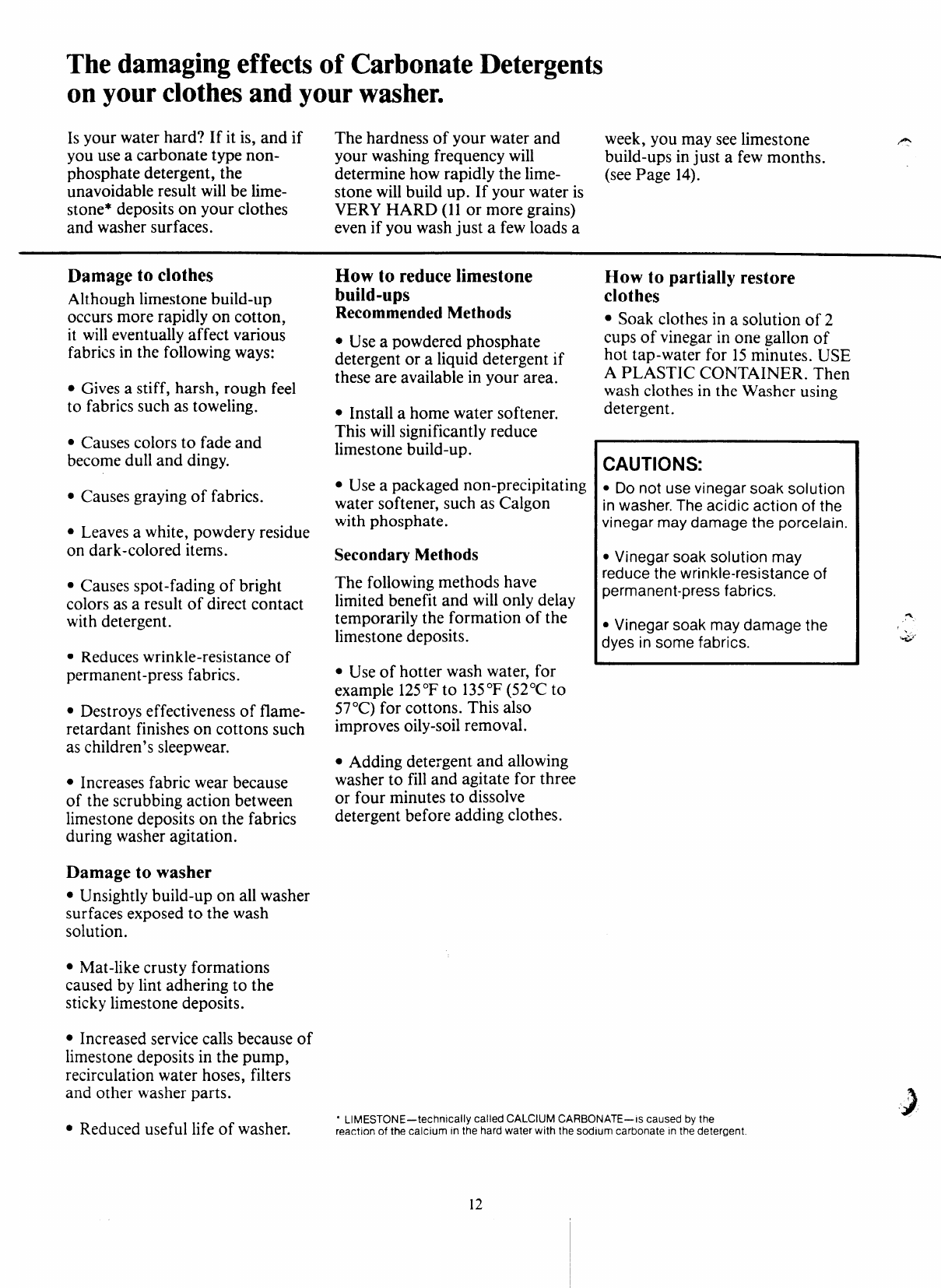
The damaging effects of Carbonate Detergents
on your clothes and your washer.
ISyour water hard? If it is, and if The hardness of your water and
week, you may see limestone
you use a carbonate type non-
your washing frequency will
build-ups in just a few months.
phosphate detergent, the
determine how rapidly the lime-
(see Page 14).
unavoidable result will be lime- stone will build up. If your water is
stone* deposits on your clothes
VERY HARD (11 or more grains)
and washer surfaces. even if you wash just a few loads a
“+
Damage to clothes
Although limestone build-up
occurs more rapidly on cotton,
it will eventually affect various
fabrics in the following ways:
● Gives a stiff, harsh, rough feel
to fabrics such as toweling.
c Causes colors to fade and
become dull and dingy.
● Causes graying of fabrics.
● Leaves a white, powdery residue
on dark-colored items.
● Causes spot-fading of bright
colors as a result of direct contact
with detergent.
● Reduces wrinkle-resistance of
permanent-press fabrics.
● Destroys effectiveness of flame-
retardant finishes on cottons such
as children’s sleepwear.
● Increases fabric wear because
of the scrubbing action between
limestone deposits on the fabrics
during washer agitation.
Damage to washer
s Unsightly build-up on all washer
surfaces exposed to the wash
solution.
● Mat-like crusty formations
caused by lint adhering to the
sticky limestone deposits.
● Increased service calls because of
limestone deposits in the pump,
recirculation water hoses, filters
and other washer parts.
c Reduced useful life of washer.
How to reduce limestone
build-ups
Recommended Methods
● Use a powdered phosphate
detergent or a liquid detergent if
these are available in your area.
● Install a home water softener.
This will significantly reduce
limestone build-up.
● Use a packaged non-precipitating
water softener, such as Calgon
with phosphate.
Secondary Methods
The following methods have
limited benefit and will only delay
temporarily the formation of the
limestone deposits.
s Use of hotter wash water, for
example 125‘F to 135‘F (52‘C to
57°C) for cottons. This also
improves oily-soil removal.
● Adding detergent and allowing
washer to fill and agitate for three
or four minutes to dissolve
detergent before adding clothes.
How to partially restore
clothes
● Soak clothes in a solution of 2
cups of vinegar in one gallon of
hot tap-water for 15minutes. USE
A PLASTIC CONTAINER. Then
wash clothes in the Washer using
detergent.
CAUTIONS:
.
Do not use vinegar soak solution
in washer. The acidic action of the
vinegar may damage the porcelain.
● Vinegar soak solution may
reduce the wrinkle-resistance of
permanent-press fabrics.
● Vinegar soak may damage the
dyes in some fabrics.
● LIMESTONE–technically tailed CALCIUM CARBONATE—Is caused by the
reaction of the calcium m the hard water with the sodium carbonate in the detergent
12


















